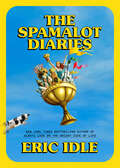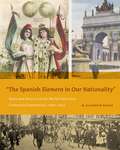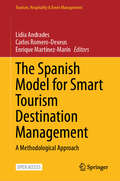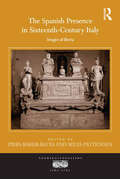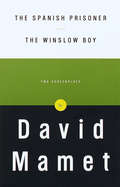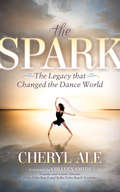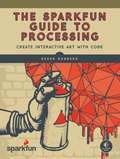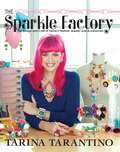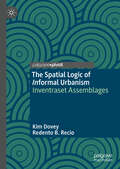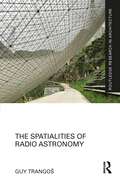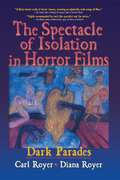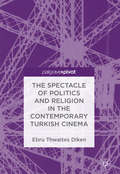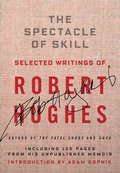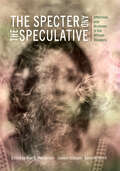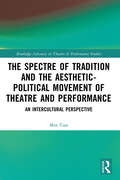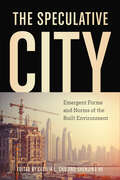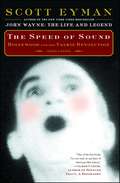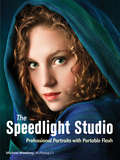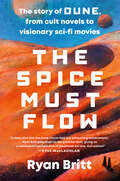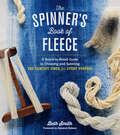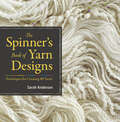- Table View
- List View
The Spamalot Diaries
by Eric Idle&“A rollicking account of the making of [the] Broadway musical Spamalot [and] an irresistible and unfiltered ode to the art of live theater. Fans will love this tantalizing glimpse behind the curtain.&”—Publishers Weekly (starred review)From comedy legend Eric Idle, the fascinating inside story of bringing Monty Python and the Holy Grail to Broadway as the unlikely theatrical hit Spamalot On March 17, 2005, Spamalot debuted on Broadway to rapturous reviews for its star-studded creative team, including creators Eric Idle and John du Prez, director Mike Nichols, and stars Hank Azaria, David Hyde Pierce, Sara Ramirez, Tim Curry, and more. But long before the show was the toast of Broadway and the winner of three Tony Awards, it was an idea threatening to fizzle out before it could find its way into existence. Now, in The Spamalot Diaries, Eric Idle shares original journal entries and raw email exchanges—all featuring his whip-smart wit—that reveal the sometimes bumpy, always entertaining path to the show&’s unforgettable run. In the months leading up to that opening night, financial anxieties were high with a low-ceiling budget and expectations that it would take two years to break even. Collaborative disputes put decades-long friendships to the test. And the endless process of rewriting was a task as passionate as it was painstaking. Still, there&’s nothing Idle would change about that year. Except for the broken ankle. He could do without the broken ankle. Chronicling every minor mishap and triumph along the way, as well as the creative tension that drove the show to new heights, The Spamalot Diaries is an unforgettable look behind the curtain of a beloved musical and inside the wickedly entertaining mind of one of our most treasured comic performers.
The Spanish Element in Our Nationality”: Spain and America at the World’s Fairs and Centennial Celebrations, 1876–1915
by M. Elizabeth Boone“The Spanish Element in Our Nationality” delves beneath the traditional “English-only” narrative of U.S. history, using Spain’s participation in a series of international exhibitions to illuminate more fully the close and contested relationship between these two countries.Written histories invariably record the Spanish financing of Columbus’s historic voyage of 1492, but few consider Spain’s continuing influence on the development of U.S. national identity. In this book, M. Elizabeth Boone investigates the reasons for this problematic memory gap by chronicling a series of Spanish displays at international fairs. Studying the exhibition of paintings, the construction of ephemeral architectural space, and other manifestations of visual culture, Boone examines how Spain sought to position itself as a contributor to U.S. national identity, and how the United States—in comparison to other nations in North and South America—subverted and ignored Spain’s messages, making it possible to marginalize and ultimately obscure Spain’s relevance to the history of the United States.Bringing attention to the rich and understudied history of Spanish artistic production in the United States, “The Spanish Element in Our Nationality” recovers the “Spanishness” of U.S. national identity and explores the means by which Americans from Santiago to San Diego used exhibitions of Spanish art and history to mold their own modern self-image.
The Spanish Model for Smart Tourism Destination Management: A Methodological Approach (Tourism, Hospitality & Event Management)
by Lidia Andrades Carlos Romero-Dexeus Enrique Martínez-MarínThis is an open access handbook that guides destinations on their journey to becoming Smart Tourism Destinations (STDs). Developed by SEGITTUR, a distinguished Spanish State company, and aligned with academia represented by Professor Lidia Andrades, who has brought together recognized international academics with SEGITTUR experts in the field of tourism management to write this groundbreaking book, it offers practical insights and strategies for success. Explore the characteristics and implications of smart destinations, across the five dimensions which structure them: destination governance, accessibility, technology, innovation and sustainability, navigate the transition from traditional tourism management to the innovative smart managerial paradigm, and overcome challenges encountered during the transformative process. Equipping destination managers with essential tools and strategies, this handbook showcases real-life examples of Spanish destinations embracing the smart tourism paradigm. Drawing on SEGITTUR's proven methodology, it provides precise guidance, checklists, and expert recommendations for effective implementation. An invaluable resource for destination managers, tourism professionals, and researchers, it unlocks the full potential of smart tourism destinations.
The Spanish Presence in Sixteenth-Century Italy: Images of Iberia (Transculturalisms, 1400-1700)
by Miles Pattenden Piers Baker-BatesThe sixteenth century was a critical period both for Spain’s formation and for the imperial dominance of her Crown. Spanish monarchs ruled far and wide, spreading agents and culture across Europe and the wider world. Yet in Italy they encountered another culture whose achievements were even prouder and whose aspirations often even grander than their own. Italians, the nominally subaltern group, did not readily accept Spanish dominance and exercised considerable agency over how imperial Spanish identity developed within their borders. In the end Italians’ views sometimes even shaped how their Spanish colonizers eventually came to see themselves. The essays collected here evaluate the broad range of contexts in which Spaniards were present in early modern Italy. They consider diplomacy, sanctity, art, politics and even popular verse. Each essay excavates how Italians who came into contact with the Spanish crown’s power perceived and interacted with the wider range of identities brought amongst them by its servants and subjects. Together they demonstrate what influenced and what determined Italians’ responses to Spain; they show Spanish Italy in its full transcultural glory and how its inhabitants projected its culture - throughout the sixteenth century and beyond.
The Spanish Prisoner and The Winslow Boy: Two Screenplays
by David MametTHE SPANISH PRISONER "Elegant, entertaining. . . . Mamet's craftiest and most satisfying cinematic puzzle. " --The New York Times THE WINSLOW BOY "One of the most subtly compelling love stories of the year. " --The New York Observer Pulitzer Prize winner David Mamet ranks among the century's most influential writers for stage and screen. His dialogue--abrasive, rhythmic--illuminates a modern aesthetic evocative of Samuel Beckett. His plots--surprising, comic, topical--have evoked comparisons to masters from Alfred Hitchcock to Arthur Miller. Here are two screenplays demonstrating the astounding range of Mamet's talents. The Spanish Prisoner, a neo-noir thriller about a research-and-development cog hoodwinked out of his own brilliant discovery, demonstrates Mamet's incomparable use of character in a dizzying tale of twists and mistaken identity. The Winslow Boy, Mamet's revisitation of Terence Rattigan's classic 1946 play, tells of a thirteen-year-old boy accused of stealing a five-shilling postal order and the tug of war for truth that ensues between his middle-class family and the Royal Navy. Crackling with wit, intelligent and surprising,The Spanish PrisonerandThe Winslow Boycelebrate Mamet's unique genius and our eternal fascination with the extraordinary predicaments of the common man.
The Spark: The Legacy that Changed the Dance World
by Cheryl AleThe Spark will help create a legacy dance students will never forget!The Spark: The Legacy that Changed the Dance World is about the journey of creative artists and dancers-turned-teachers who are now struggling with the complexities of teaching. Choosing a ballet program that juggles all styles, techniques, and methodologies and that all levels of students will progressively love is a daunting task. In this book, dance teachers will discover what the greatest masters have always known: the true essence of dancing. Quite simply, they will learn how to teach pure, fluid movement with an age-appropriate curriculum proven for the past 60 years to effectively transcend any limiting beliefs about the basis for all dance. If you’re looking for an empowered learning community with the perfect balance of discipline, integrity, and a curriculum that forms lifetime bonds with students, teachers, and parents, you’ve come to the right place. Celebrate your “sparkdom”!
The SparkFun Guide to Processing
by Derek RunbergProcessing is a free, beginner-friendly programming language designed to help non-programmers create interactive art with code.The SparkFun Guide to Processing, the first in the SparkFun Electronics series, will show you how to craft digital artwork and even combine that artwork with hardware so that it reacts to the world around you. Start with the basics of programming and animation as you draw colorful shapes and make them bounce around the screen. Then move on to a series of hands-on, step-by-step projects that will show you how to:–Make detailed pixel art and scale it to epic proportions–Write a maze game and build a MaKey MaKey controller with fruit buttons–Play, record, and sample audio to create your own soundboard–Fetch weather data from the Web and build a custom weather dashboard–Create visualizations that change based on sound, light, and temperature readingsWith a little imagination and Processing as your paintbrush, you’ll be on your way to coding your own gallery of digital art in no time! Put on your artist’s hat, and begin your DIY journey by learning some basic programming and making your first masterpiece with The SparkFun Guide to Processing.The code in this book is compatible with Processing 2 and Processing 3.
The Sparkle Factory: The Design and Craft of Tarina's Fashion Jewelry and Accessories
by Tarina TarantinoTarina Tarantino's love affair with fashion jewelry and accessories began when she was just a little girl. Tarina now owns and operates her famous global jewelry, accessories, and cosmetics brand, TARINA TARANTINO, out of her international headquarters in downtown Los Angeles, The Sparkle Factory. In her first book, Tarina invites you into her world to learn how to make and wear beautiful and inspirational fashion jewelry. Fashionistas, aspiring jewelry designers, and DIY lovers will learn how to make 20 of Tarina's most essential pieces including statement earrings, cocktail rings, hair jewelry, stretch cuff bracelets, embellished spectacles, and more. Fans of Tarina will also learn about her brand history, getting inspired, creating themes and stories, sourcing materials, essential tools and techniques, how to wear and style your jewelry wardrobe, and more. The text is complemented by tips and hundreds of full-color photos throughout.
The Spatial Logic of Informal Urbanism: Inventraset Assemblages
by Kim Dovey Redento B. RecioHighly informalized cities of the global South are often portrayed as chaotic and out of control - this book reveals a spatial logic of informal urbanism that is central to the economic life and livelihoods of such cities. 'Inventraset' is a concept that shows how informal street vending, transport and settlement are fundamentally integrated with each other and the more formal city. Street vending and transport provide crucial forms of employment and mobility, while informal settlement is the key source of affordable and adaptable housing. Informal urbanism is not ideal but it is the way such cities work; it is often hidden or camouflaged within the ideal of a clean, green and modern city to which middle-classes and elites aspire. Through comparative studies, with a focus on Manila and Jakarta, the book maps and analyzes how such cities work through alliances and synergies between vending, transport and settlement - inventraset assemblages are inventive and transgressive, yet settled.
The Spatialities of Radio Astronomy (Routledge Research in Architecture)
by Guy TrangošThe Spatialities of Radio Astronomy examines the multidisciplinary overlap between the spatial disciplines and the studies of science and technology through a comparative study of four of the world’s most important radio telescopes. Employing detailed analysis, historical research, interviews, personal observations, and various conceptual manoeuvres, Guy Trangoš reveals the depth of spatial process active at these scientific sites and the territories they traverse. Through the conceptual frameworks of territory, hyper-concentration, and contingency, Trangoš interprets the telescope as exploded across space and time, present in multiple connected sites simultaneously, and active in the production of space. He develops a historiographic and contemporary analysis of the Atacama Large Millimeter/submillimeter Array (ALMA, Chile); the Five-hundred-meter Aperture Spherical radio Telescope (FAST, China); the Arecibo Observatory (Puerto Rico); and the MeerKAT/SKA (South Africa). These case studies are global exemplars of the different spatial transformations that occur through science. Their relationships to surrounding communities and landscapes reveal deeper constitutional processes embodied in each institutional and spatial form. This book spans the modern history of architecture and science, the studies of science, technology and society, and urban theory. It is of specific interest to architects and designers expanding their analysis of spatial production, scholars in the study of geography, landscape, science, technology, and astronomy, and people fascinated with how these radio telescopes were conceptualised, built, and operate today.
The Spectacle of Isolation in Horror Films: Dark Parades
by Carl Royer B Lee CooperGo behind the scenes with an insightful look at horror films-and the directors who create them The Spectacle of Isolation in Horror Films: Dark Parades examines the work of several of the genre&’s most influential directors and investigates how traditional themes of isolation, alienation, death, and transformation have helped build the foundation of horror cinema. Authors Carl and Diana Royer examine the techniques used by Alfred Hitchcock that place his work squarely in the horror (rather than suspense) genre, discuss avant-garde cinema&’s contributions to mainstream horror, explore films that use the apartment setting as the "cell of horror," and analyze how angels and aliens function as the supernatural "Other." A unique resource for film students and film buffs alike, the book also examines Sam Raimi&’s Evil Dead trilogy and the fusion of science, technology, and quasi-religious themes in David Cronenberg&’s films. Instead of presenting a general overview of the horror genre or an analysis of a specific sub-genre, actor, or director, The Spectacle of Isolation in Horror Films offers an imaginative look at classic and contemporary horror cinema. The book examines Surrealist films such as Un Chien Andalou and Freaks, the connections among the concepts of voyeurism, paranoia, and alienation in films like Rear Window, Rosemary&’s Baby, Blue Velvet, and The Blair Witch Project; the use of otherworldly creatures in films such as The Prophecy, Dogma, and The Day The Earth Stood Still; and the films of directors George Romero, John Waters, and Darren Aronofsky, to name just a few. This unique book also includes an extensive A-to-Z filmography and a bibliography of writings on, and about, horror cinema from filmmakers, film critics, and film historians. The Spectacle of Isolation in Horror Films examines: "Body Doubles and Severed Hands"-the common ancestry of avant-garde "art" films and exploitation horror B-movies "And I Brought You Nightmares"-recurring themes of psychological terror in Alfred Hitchcock&’s films "Horror, Humor, Poetry"-Sam Raimi&’s transformation of "drive-in" horror cinema "Atheism and 'The Death of Affect'"-David Cronenberg&’s obsessions, interests, and cautionary messages in films ranging from Videodrome to Dead Ringers to eXistenZ and much more!The Spectacle of Isolation in Horror Films: Dark Parades is a unique resource of critical analysis for academics working in film and popular culture, film historians, and anyone interested in horror cinema.
The Spectacle of Politics and Religion in the Contemporary Turkish Cinema
by Ebru Thwaites DikenThis book explores how politics, religion and cinema encounter and re-invent each other in contemporary Turkish cinema. It investigates their common origin—the spectacle, which each field views as an instrument of governmentality. The book analyses six recent, some of which are internationally known Turkish films: The Messenger (Ulak), A Man’s Fear of God (Takva), Let’s Sin (İtirazım Var), SixtyOne Days (İftarlık Gazoz), The Imam and The Shadowless (Gölgesizler). Thwaites discusses how the cinematic nature of politics and religion unfold amidst the increasing media visibility of religion in contemporary Turkey. The chapters explore the relationship between art and religion, and compare religion and philosophy in their relation to truth, belief, and economy. Through close examination of these films, the author highlights the role of cinema in contemporary Turkey and at the heart of the religious paradigm.
The Spectacle of Skill
by Adam Gopnik Robert Hughes"I am completely an elitist, in the cultural but emphatically not the social sense. I prefer the good to the bad, the articulate to the mumbling, the aesthetically developed to the merely primitive, and full to partial consciousness. I love the spectacle of skill, whether it's an expert gardener at work, or a good carpenter chopping dovetails . . . I don't think stupid or ill-read people are as good to be with as wise and fully literate ones. I would rather watch a great tennis player than a mediocre one . . . Consequently, most of the human race doesn't matter much to me, outside the normal and necessary frame of courtesy and the obligation to respect human rights. I see no reason to squirm around apologizing for this. I am, after all, a cultural critic, and my main job is to distinguish the good from the second-rate." Robert Hughes wrote with brutal honesty about art, architecture, culture, religion, and himself. He translated his passions--of which there were many, both positive and negative--brilliantly, convincingly, and with vitality and immediacy, always holding himself to the same rigorous standards of skill, authenticity, and significance that he did his subjects. There never was, and never will be again, a voice like this. In this volume, that voice rings clear through a gathering of some of his most unforgettable writings, culled from nine of his most widely read and important books. This selection shows his enormous range and gives us a uniquely cohesive view of both the critic and the man. Most revealing, and most thrilling for Hughes's legions of fans, are the never-before-published pages from his unfinished second volume of memoirs. These last writings show Robert Hughes at the height of his powers and can be read only with pleasure and a tinge of sadness that his extraordinary voice is no longer here to educate us as well as to clarify and define our world.From the Hardcover edition.
The Spectacle of Skill: New and Selected Writings of Robert Hughes
by Adam Gopnik Robert Hughes"I am completely an elitist, in the cultural but emphatically not the social sense. I prefer the good to the bad, the articulate to the mumbling, the aesthetically developed to the merely primitive, and full to partial consciousness. I love the spectacle of skill, whether it's an expert gardener at work, or a good carpenter chopping dovetails . . . I don't think stupid or ill-read people are as good to be with as wise and fully literate ones. I would rather watch a great tennis player than a mediocre one . . . Consequently, most of the human race doesn't matter much to me, outside the normal and necessary frame of courtesy and the obligation to respect human rights. I see no reason to squirm around apologizing for this. I am, after all, a cultural critic, and my main job is to distinguish the good from the second-rate." Robert Hughes wrote with brutal honesty about art, architecture, culture, religion, and himself. He translated his passions--of which there were many, both positive and negative--brilliantly, convincingly, and with vitality and immediacy, always holding himself to the same rigorous standards of skill, authenticity, and significance that he did his subjects. There never was, and never will be again, a voice like this. In this volume, that voice rings clear through a gathering of some of his most unforgettable writings, culled from nine of his most widely read and important books. This selection shows his enormous range and gives us a uniquely cohesive view of both the critic and the man. Most revealing, and most thrilling for Hughes's legions of fans, are the never-before-published pages from his unfinished second volume of memoirs. These last writings show Robert Hughes at the height of his powers and can be read only with pleasure and a tinge of sadness that his extraordinary voice is no longer here to educate us as well as to clarify and define our world.From the Hardcover edition.
The Specter and the Speculative: Afterlives and Archives in the African Diaspora
by Mae G. Henderson Jeanne Scheper Emily Ruth Rutter Danielle Fuentes Morgan Fernando Gabriel Pagnoni Berns Gene Melton Diana Arterian Christopher Giroux Stella Setka Meina Yates-Richard Luis Omar Ceniceros Shamika Ann Mitchell Andrew R. Belton Kim White Sheila Smith McKoy Pekka Kilpeläinen Emiliano Aguilar Juan Ignacio Juvé Kajsa K. Henry McKinley E. MeltonThe Specter and the Speculative: Afterlives and Archives in the African Diaspora engages in a critical conversation about how historical subjects and historical texts within the African Diaspora are re-fashioned, re-animated, and re-articulated, as well as parodied, nostalgized, and defamiliarized, to establish an “afterlife” for African Atlantic identities and narratives. These essays focus on transnational, transdisciplinary, and transhistorical sites of memory and haunting—textual, visual, and embodied performances—in order to examine how these “living” archives circulate and imagine anew the meanings of prior narratives liberated from their original context. Individual essays examine how historical and literary performances—in addition to film, drama, music, dance, and material culture—thus revitalized, transcend and speak across temporal and spatial boundaries not only to reinstate traditional meanings, but also to motivate fresh commentary and critique. Emergent and established scholars representing diverse disciplines and fields of interest specifically engage under explored themes related to afterlives, archives, and haunting.
The Spectre of Tradition and the Aesthetic-Political Movement of Theatre and Performance: An Intercultural Perspective (Routledge Advances in Theatre & Performance Studies)
by Min TianThis book interrogates anew the phenomenon of tradition in a dialogical debate with a host of Western thinkers and critical minds. In contrast to the predominantly Western approaches, which look at traditions (Western and non-Western) from a predominantly (Western) modernist perspective, this book interrogates, from an intercultural perspective, the transnational and transcultural consecration, translation, (re)invention, and displacement of traditions (theatrical and cultural) in the aesthetic-political movement of twentieth-century theatre and performance, as exemplified in the case studies of this book. It looks at the question of traditions and modernities at the centre of this aesthetic-political space, as modernities interculturally evoke and are haunted by traditions, and as traditions are interculturally refracted, reconstituted, refunctioned, and reinvented. It also looks at the applicability of its intercultural perspective on tradition to the historical avant-garde in general, postmodern, postcolonial, and postdramatic theatre and performance and to the twentieth-century "classical" intercultural theatre and the twenty-first-century "new interculturalisms" in theatre and performance. To conclude, it looks at the future of tradition in the ecology of our globalized theatrum mundi and considers two important interrelated concepts, future tradition and intercultural tradition. This book will be of great interest to students and scholars in performance studies.
The Speculative City: Art, Real Estate, and the Making of Global Los Angeles
by Susanna Phillips NewburyA forensic examination of the mutual relationship between art and real estate in a transforming Los Angeles Underlying every great city is a rich and vibrant culture that shapes the texture of life within. In The Speculative City, Susanna Phillips Newbury teases out how art and Los Angeles shaped one another&’s evolution. She compellingly articulates how together they transformed the Southland, establishing the foundation for its contemporary art infrastructure, and explains how artists came to influence Los Angeles&’s burgeoning definition as the global city of the twenty-first century.Pairing particular works of art with specific innovations in real estate development, The Speculative City reveals the connections between real estate and contemporary art as they constructed Los Angeles&’s present-day cityscape. From banal parking lots to Frank Gehry&’s designs for artists&’ studios and museums, Newbury examines pivotal interventions by artists and architects, city officials and cultural philanthropists, concluding with an examination of how, in the wake of the 2008 global credit crisis, contemporary art emerged as a financial asset to fuel private wealth and urban gentrification. Both a history of the transformation of the Southland and a forensic examination of works of art, The Speculative City is a rich complement to the California chronicles by such writers as Rebecca Solnit and Mike Davis.
The Speculative City: Emergent Forms and Norms of the Built Environment
by Shenjing He Cecilia L. ChuThe Speculative City explores property speculation as a key aspect of financialization and its role in reshaping the contemporary built environment. The book offers a series of case studies that encompass a range of cities whose urban fabrics have undergone significant transformation in recent years. While the forms of these developments shared many similarities, their trajectories and social outcomes were contingent upon existing planning and policy frameworks and the historical roles assumed by the state and the private sector in housing and welfare provision. By paying close attention to the forces and actors involved in property development, this book underscores that the built environment has played an integral part in the shaping of new values and collective aspirations while facilitating the spread of financial logics in urban governance. It also shows that these dynamics represent a larger shift of politics and culture in the ongoing production of urban space and prompts reflections on future trajectories of finance-led property speculation.
The Speed of Sound: Hollywood and the Talkie Revolution 1926-1930
by Scott EymanFor the first time ever, here is the epic story of the transition from silent films to talkies - that moment when movies were totally transformed and the American public cemented its love affair with Hollywood. In the Speed of Sound, author Scott Eyman, whose biography of filmmaker Ernst Lubitsch was hailed as "resoundingly wonderful," has created a mixture of cultural and social history that is at once both scholarly and vastly entertaining. Here is the first and last. word on the missing chapter in the history of Hollywood, the ribbon of dreams by which America conquered the world. Myth has it that it happened overnight, that Al Jolson said a few words in The Jazz Singer and the talkies were born, that stars with weak or inappropriate voices either killed themselves or went into seclusion, that the movie industry simply refitted itself and went on with business. The truth, however, is more involved - not to mention sinister, colorful, and entertaining. Sound was something the industry had resisted, and it was accepted only reluctantly and only after the Warner Bros. Studio had forced the issue with its aggressive selling of The Jazz Singer. But that was 1927, and for a long time afterward there were still those filmmakers, film stars, and even some filmgoers who resisted the appealing novelty. Change, however, was inevitable, and when it came it was devastating. As Scott Eyman demonstrates in his fascinating account of this exciting era, it was a time when fortunes, careers, and lives were made and lost, when the American film industry came fully into its own, and when the American film-going public truly succumbed to Hollywood's bewitching spell.
The Speedlight Studio
by Michael MowbrayIn this book, Michael Mowbray shows readers how to set up a completely speedlight-based portrait photography studio. He goes in depth regarding gear and techniques, providing photographers with scores of example portraits and lighting diagrams to make it easy to follow along and replicate the portrait lighting effects that he shows. Readers will learn about selecting speedlights (Mowbray covers Canon, Nikon, and third-party units), learning standard operations, and working with the units on the camera’s hot shoe (a connectivity device on top of the camera) or in the periphery for more flexible, controllable results. Readers will learn why modifying the light from speedlights will produce a lot more bang for their buck and will also discover a host of tools-commercial and DIY-that can be used to change the direction, color, and quality of light for the ultimate artistic control.
The Speedlight Studio
by Michael MowbrayIn this book, Michael Mowbray shows readers how to set up a completely speedlight-based portrait photography studio. He goes in depth regarding gear and techniques, providing photographers with scores of example portraits and lighting diagrams to make it easy to follow along and replicate the portrait lighting effects that he shows. Readers will learn about selecting speedlights (Mowbray covers Canon, Nikon, and third-party units), learning standard operations, and working with the units on the camera’s hot shoe (a connectivity device on top of the camera) or in the periphery for more flexible, controllable results. Readers will learn why modifying the light from speedlights will produce a lot more bang for their buck and will also discover a host of tools-commercial and DIY-that can be used to change the direction, color, and quality of light for the ultimate artistic control.
The Speedlight Studio
by Michael MowbrayIn this book, Michael Mowbray shows readers how to set up a completely speedlight-based portrait photography studio. He goes in depth regarding gear and techniques, providing photographers with scores of example portraits and lighting diagrams to make it easy to follow along and replicate the portrait lighting effects that he shows. Readers will learn about selecting speedlights (Mowbray covers Canon, Nikon, and third-party units), learning standard operations, and working with the units on the camera's hot shoe (a connectivity device on top of the camera) or in the periphery for more flexible, controllable results. Readers will learn why modifying the light from speedlights will produce a lot more bang for their buck and will also discover a host of tools-commercial and DIY-that can be used to change the direction, color, and quality of light for the ultimate artistic control.
The Spice Must Flow: The Story of Dune, from Cult Novels to Visionary Sci-Fi Movies
by Ryan BrittGeek-culture expert Ryan Britt takes us behind the pages and scenes of the science-fiction phenomenon Dune, charting the series' life from cult sci-fi novels to some of the most visionary movies of all time. Using original, deep-access reporting, extensive research, and insightful commentary, The Spice Must Flow brings the true popularity of Dune out into the light for the very first time. With original interviews with the beloved actors and directors behind the films—including Timothée Chalamet, Kyle Maclachlan, Denis Villeneuve, Patrick Stewart, Rebecca Ferguson, Alec Newman, and many more— The Spice Must Flow also examines the far-reaching influence of Dune on art, music, politics, and, most notably, its status as the first ecological science-fiction story specifically concerned with climate change. Britt skillfully and entertainingly guides readers through the history of how the Dune universe has unfolded, including the novel&’s unlikely evolution from a failed piece of journalism about Oregon sand dunes into an epic science-fiction story, the way Herbert&’s work inspired George Lucas, untold stories from the 1984 David Lynch film, the knife-edge balance between blockbuster hit and indie film Timothée Chalamet brings to the 2021 movie, and the exciting future of the franchise. Through a blend of narrative, oral history elements, and fascinating trivia, The Spice Must Flow is the new essential guide to the behind-the-scenes story of Dune. The fiction of Dune is deadly serious, but the real-life story of how it came into existence is full of wonder, surprises, and spice.
The Spinner's Book of Fleece: A Breed-by-Breed Guide to Choosing and Spinning the Perfect Fiber for Every Purpose
by Deborah Robson Beth SmithThe characteristics of fleece — its structure, grease content, and fiber diameter — vary widely depending on the breed of sheep the fleece comes from. In this comprehensive guide, Beth Smith profiles 21 types of fleece, from bouncy and pliant to lacy and lightweight. A sheep-by-sheep reference describes the best way to wash and spin each fleece into rich, soft yarn. You’ll soon be confidently choosing the right fleece, spinning it to perfection, and enjoying the perfect yarn for your next fiber creation.
The Spinner's Book of Yarn Designs: Techniques for Creating 80 Yarns
by Sarah Anderson Judith MacKenzieDiscover the satisfying fun of spinning your own yarn! This step-by-step guide shows you how to create 80 distinctive yarn types, from classics like mohair bouclé to novelties like supercoils. Covering the entire spinning process, Sarah Anderson describes the unique architecture of each type of yarn and shares expert techniques for manipulating and combining fibers. Take your crafting to a new level and ensure that you have the best yarn available by spinning it yourself.
